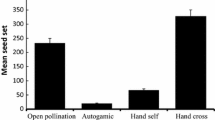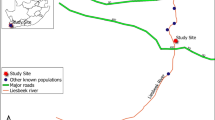Abstract
One of the essential requirements for an introduced plant species to become invasive is an ability to reproduce outside the native range, particularly when initial populations are small. If a reproductive Allee effect is operating, plants in small populations will have reduced reproductive success relative to plants in larger populations. Alternatively, if plants in small populations experience less competition for pollination than those in large populations, they may actually have higher levels of reproductive success than plants in large populations. To resolve this uncertainty, we investigated how the per capita fecundity of plants was affected by population size in three invasive milkweed species. Field surveys of seed production in natural populations of different sizes but similar densities were conducted for three pollinator-dependent invasive species, namely Asclepias curassavica, Gomphocarpus fruticosus and G. physocarpus. Additionally, supplemental hand-pollinations were performed in small and large populations in order to determine whether reproductive output was limited by pollinator activity in these populations. Reproductive Allee effects were not detected in any of the study species. Instead, plants in small populations exhibited remarkably high levels of reproductive output compared to those in large populations. Increased fruit production following supplemental hand-pollinations suggested that the lower reproductive output of naturally pollinated plants in large populations is a consequence of pollen limitation rather than limitation due to abiotic resources. This is consistent with increased intraspecific competition for pollination amongst plants in large populations. It is likely that the invasion of these milkweed species in Australia has been enhanced because plants in small founding populations experience less intraspecific competition for pollinators than those in large populations, and thus have the ability to produce copious amounts of seeds.

Similar content being viewed by others
References
Ågren J (1996) Population size, pollinator limitation, and seed set in the self-incompatible herb Lythrum salicaria. Ecology 77:1779–1790
Aizen MA (1997) Influence of local floral density and sex ratio on pollen receipt and seed output: empirical and experimental results in dichogamous Alstroemeria aurea (Alstroemeriaceae). Oecologia 111:404–412
Alexandersson R, Ågren J (1996) Population size, pollinator visitation, and fruit production in the deceptive orchid Calypso bulbosa. Oecologia 107:533–540
Ashman TL, Knight TM, Steets JA, Amarasekare P, Burd M, Campbell DR, Dudash MR, Johnston MO, Mazer SJ, Mitchell RJ, Morgan MT, Wilson WG (2004) Pollen limitation of plant reproduction: ecological and evolutionary causes and consequences. Ecology 85:2408–2421
Bierzychudek P (1981) Pollinator limitation of plant reproductive effort. Am Nat 117:838–840
Burd M (1994) Bateman’s principle and plant reproduction: the role of pollen limitation in fruit and seed set. Bot Rev 60:83–139
Campbell LG, Husband BC (2007) Small populations are mate-poor but pollinator-rich in a rare, self-incompatible plant, Hymenoxys herbacea (Asteraceae). New Phytol 174:915–925
Cappuccino N (2004) Allee effect in an invasive alien plant, pale swallow-wort Vincetoxicum rossicum (Asclepiadaceae). Oikos 106:3–8
Coombs G, Peter CI, Johnson SD (2009) A test for Allee effects in the self-incompatible wasp-pollinated milkweed Gomphocarpus physocarpus. Austral Ecol 34:688–697
Cunningham SA (2000) Depressed pollination in habitat fragments causes low fruit set. Proc R Soc Lond B 267:1149–1152
Davis HG, Taylor CM, Civille JC, Strong DR (2004a) An Allee effect at the front of a plant invasion: Spartina in a Pacific estuary. J Ecol 92:321–327
Davis HG, Taylor CM, Lambrinos JG, Strong DR (2004b) Pollen limitation causes an Allee effect in a wind-pollinated invasive grass (Spartina alterniflora). Proc Natl Acad Sci USA 101:13804–13807
Ehrlén J, Eriksson O (1995) Pollen limitation and population growth in a herbaceous perennial legume. Ecology 76:652–656
Ellstrand NC, Elam DR (1993) Population genetic consequences of small population size: implications for plant conservation. Annu Rev Ecol Syst 24:217–242
Endress ME, Bruyns PV (2000) A revised classification of the Apocynaceae s.l. Bot Rev 66:1–56
Forster PI (1994) Diurnal insects associated with the flowers of Gomphocarpus physocarpus E. Mey. (Asclepiadaceae), an introduced weed in Australia. Biotropica 26:214–217
Forsyth SA (2003) Density-dependent seed set in the Haleakala silversword: evidence for an Allee effect. Oecologia 136:551–557
Grindeland JM, Sletvold N, Ims RA (2005) Effects of floral display size and plant density on pollinator visitation rate in a natural population of Digitalis purpurea. Funct Ecol 19:383–390
Groom MJ (1998) Allee effects limit population viability of an annual plant. Am Nat 151:487–496
Guo X, Pan W, Connett JE, Hannan PJ, French SA (2005) Small-sample performance of the robust score test and its modifications in generalised estimating equations. Stat Med 24:3479–3495
Højsgaard S, Halekoh U, Yan J (2005) The R package geepack for generalised estimating equations. J Stat Softw 15:1–11
Johnson SD, Torninger E, Ågren J (2009) Relationships between population size and pollen fates in a moth-pollinated orchid. Biol Lett 5:282–285
Johnson SD, Hollens H, Kulhmann M (2011) Competition versus facilitation: conspecific effects on pollinator visitation and seed set in the iris Lapeirousia oreogena. Oikos 121:545–550
Klank C, Pluess AR, Ghazoul J (2010) Effects of population size on plant reproduction and pollinator abundance in a specialized pollination system. J Ecol 98:1389–1397
Knight TM, Steets JA, Ashman TL (2006) A quantitative synthesis of pollen supplementation experiments highlights the contribution of resource reallocation to estimates of pollen limitation. Am J Bot 93:271–277
Lamont BB, Klinkhamer PGL, Witkowski ETF (1993) Population fragmentation may reduce fertility to zero in Banksia goodii: a demonstration of the Allee effect. Oecologia 94:446–450
Larson KC, Fowler SP, Walker JC (2002) Lack of pollinators limits fruit set in the exotic Lonicera japonica. Am Midl Nat 148:54–60
Leimu R, Mutikainen P, Koricheva J, Fischer M (2006) How general are positive relationships between plant population size, fitness and genetic variation? J Ecol 94:942–952
Lewis MA, Kareiva P (1993) Allee dynamics and the spread of invading organisms. Theor Popul Biol 43:141–158
Liang KY, Zeger S (1986) Longitudinal data analysis using generalised linear models. Biometrika 73:13–22
Moody ME, Mack RN (1988) Controlling the spread of plant invasions—the importance of nascent foci. J Appl Ecol 25:1009–1021
Morgan JW (1999) Effects of population size on seed production and germinability in an endangered, fragmented grassland plant. Conserv Biol 13:266–273
Mustajärvi K, Siikamaki P, Rytkonen S, Lammi A (2001) Consequences of plant population size and density for plant–pollinator interactions and plant performance. J Ecol 89:80–87
Parker IM (1997) Pollinator limitation of Cytisus scoparius (Scotch broom), an invasive exotic shrub. Ecology 78:1457–1470
Quinn GP, Keough MJ (2002) Experimental design and data analysis for biologists, 1st edn. Cambridge University Press, Cambridge
Raijmann LL, Van Leeuwen NC, Kersten R, Oostermeijer JGB, Dennijs HCM, Menken SBJ (1994) Genetic variation and outcrossing rate in relation to population size in Gentiana pneumonanthe L. Conserv Biol 8:1014–1026
Rambuda TD, Johnson SD (2004) Breeding systems of invasive alien plants in South Africa: does Baker’s rule apply? Divers Distrib 10:409–416
Rathcke B (1983) Competition and facilitation amongst plants for pollination. In: Readl L (ed) Pollination biology. Academic, Orlando, pp 305–329
R Development Core Team (2011) R: A language and environment for statistical computing. R Foundation for Statistical Computing, Vienna, Austria. ISBN 3-900051-07-0, URL http://www.R-project.org
Richardson DM, Allsopp N, D’Antonio CM, Milton SJ, Rejmánek M (2000) Plant invasions—the role of mutualisms. Biol Rev 75:65–93
Sih A, Baltus MS (1987) Patch size, pollinator behaviour, and pollinator limitation in Catnip. Ecology 68:1679–1690
Spigler RB, Chang S-M (2009) Pollen limitation and reproduction varies with population size in experimental populations of Sabatia angularis (Gentianaceae). Botany 87:330–338
Stephens PA, Sutherland WJ, Freckleton RP (1999) What is the Allee effect? Oikos 87:185–190
Steven JC, Rooney TP, Boyle OD, Waller DM (2003) Density-dependent pollinator visitation and self-incompatibility in upper Great Lakes populations of Trillium grandiflorum. J Torrey Bot Soc 130:23–29
Stoutamire WP (1971) Pollination in temperate American orchids. In: Corrigan MJ (ed) Proceedings of the Sixth World Orchid Conference. Australia, Sydney, pp 233–243
van Kleunen M, Johnson SD (2005) Testing for ecological and genetic allee effects in the invasive shrub Senna didymobotrya (Fabaceae). Am J Bot 92:1124–1130
van Kleunen M, Fischer M, Johnson SD (2007) Reproductive assurance through self-fertilisation does not vary with population size in the alien invasive plant Datura stramonium. Oikos 116:1400–1412
van Treuren R, Bulsma R, Ouborg NJ, van Delden W (1993) The effects of population size and plant density on outcrossing rates in locally endangered Salvia pratensis. Evolution 47:1094–1104
Ward M, Johnson SD (2005) Pollen limitation and demographic structure in small fragmented populations of Brunsvigia radulosa (Amaryllidaceae). Oikos 108:53–262
Ward M, Johnson SD, Zalucki MP (2012) Modes of reproduction in three invasive milkweeds are consistent with Baker’s rule. Biol Invasions 14:1237–1250
Widén B (1993) Demographic and genetic effects on reproduction as related to population size in a rare, perennial herb, Senecio integrifolius (Asteraceae). Biol J Linn Soc 50:179–195
Willi Y, Fischer M (2005) Genetic rescue in interconnected populations of small and large size of the self-incompatible Ranunculus reptans. Heredity 95:437–443
Woodson RE (1954) The North American species of Asclepias L. Ann Mo Bot Gard 41:1–211
Wyatt R (1976) Pollination and fruit-set in Asclepias: a reappraisal. Am J Bot 63:845–851
Wyatt R, Broyles SB, Lipow SR (2000) Pollen-ovule ratios in milkweeds (Asclepiadaceae): an exception that probes the rule. Syst Bot 25:171–180
Zorn-Arnold B, Howe HF (2007) Density and seed set in a self-compatible forb, Penstemon digitalis (Plantaginaceae), with multiple pollinators. Am J Bot 94:1594–1602
Acknowledgments
The authors thank Y. Buckley and two anonymous reviewers for comments on an earlier draught of the manuscript. Funding for this research was provided by CSIRO Sustainable Ecosystems and the DST-NRF Centre for Invasion Biology. The authors declare that they have no conflict of interest and that all experiments were conducted in compliance with Australian law.
Author information
Authors and Affiliations
Corresponding author
Additional information
Communicated by Christina Caruso.
Rights and permissions
About this article
Cite this article
Ward, M., Johnson, S.D. & Zalucki, M.P. When bigger is not better: intraspecific competition for pollination increases with population size in invasive milkweeds. Oecologia 171, 883–891 (2013). https://doi.org/10.1007/s00442-012-2463-0
Received:
Accepted:
Published:
Issue Date:
DOI: https://doi.org/10.1007/s00442-012-2463-0




